

![[DIGITALE BIBLIOTHEK DER FES]](/images/digbib/d_digbib.gif)

SECTION of DOCUMENT:
[page-number of print edition: 253]
UNEMPLOYMENT AND HIDDEN ECONOMY
Anna Mantarova, Sofia
The existence of an economy which is different from the officially registered one is an indisputable reality in contemporary societies. It is present in countries with well-developed market economies, in the developing countries and in those which are shifting from centralised to market economy. There are different causes and conditions for the existence of these economies. There are also differences in terms of the scale and the fields which the shadow economy mostly covers. Nevertheless, in their core the problems related to them are quite similar. They are especially acute for the Bulgarian society, since large groups experience considerable economic hardships in the course of the ongoing macrosocial transformation. Social integration is disrupted, the value-normative systems are destabilised. The hidden economy is vast in size, and its negative economic and social consequences are a considerable supplementary burden for the society and for the individuals.
The hidden economy incurs substantial economic damages by diverting finances from income and profit taxes from the state budget and the social security funds. The negative consequences in terms of social benefits are tangible. Other negative social effects are also numerous and various. Deformed models of working relations are being established in the transition to market economy. The vast share of the hidden economy and the usage of labour power with various profiles and qualifications in it leads to a general marginalisation of the labour force.
The hidden economy has a negative impact on the opportunities for developing the human factor. As a rule, the employment conditions in it provide a lower quality of working life. The conditions for work, rest and recreation often remain outside the framework guaranteed by the labour legislation. The problem is
[page-number of print edition: 254]
especially acute when the employment of juvenile and underage workers is concerned. The evading of labour legislation has a negative effect on their opportunities to get a good education, which would give them equal position and worth on the labour market in the future. The start of the health-insurance system and the future changes in the pension security funds would further strengthen social divergence.
The hidden economy has a considerable influence on the economic stratification. The differences between the incomes of employers and employees are especially tangible in this sector. The former evade taxation and insurance fees and thus realise high profits. The latter usually have lower earnings than the ones received for similar work in the legal economy. As a rule, the unexpected expenses and losses in case of incapacitation have to be covered by the employee. Payments for work which has been already completed are also not secure. Thus the hidden economy increases the stratification of society on an illegitimate basis. This is one of the serious obstacles on the way to social integration. The economic effectiveness and the actual lack of sanctions against illegal conduct have a strong negative impact on the value-systems and the attitudes towards the state and the state institutions.
Of no less importance are the crime-fostering effects of the hidden economy. In its very core it is a breach of valid labour, tax, social and other legal arrangements, but along with this it has a strong additional negative influence. The capitals generated in it are widely used for corruption activities.
1. Terminological Clarifications
In spite of the researches on shadow economy, intensively conducted in many countries during the last years, the terminology used in them is not sufficiently elaborated and precise. The terms black, criminal, illegal, unregistered, hidden, shadow, grey, informal economy are widely used. When applied to particular cases they are often not used as synonyms. In mass usage,
[page-number of print edition: 255]
but also in scientific publications, one and the same term is loaded with different meanings, or one and the same phenomenon is named in different ways. Precisely due to the lack of synonymous usage of the terms which stand for the various activities outside the framework of the registered economy, it is necessary to clarify the contents which is used further on.
The hidden or informal economy stands for the establishment and allocation of incomes out of public control. It encompasses the relations in illegal and/or hidden forms, which emerge with the production and market realisation of goods and services, the accumulation and reallocation of incomes, along with the employment and self-employment of labour force. The illegal /or black/ economy includes the production, supply and realisation of goods and services which are banned by law, or the production, supply and realisation of goods and services by unauthorised /unlicensed or uncertified/ economic subjects. The secret economy includes the production, supply and realisation of legally approved goods and services, but due to various reasons done in a wholly or partially secret way (see also Hristoskov, Shopov and Beleva,1996).
The participation in the hidden economy is realised via labour, position or capital /money, means of production, property/. Researchers have distinguished two groups of actors. The first one comprises of rich people, or those who are becoming rich. The second one comprises of poor people, or those who are becoming impoverished. The former are active participants and deal with large capitals within or close to the sphere of hidden economy. The latter look for supplementary incomes in order to prevent further impoverishment. The greatest part of the participants in the hidden economy are either hired workers or self-employed. The distinction between hired workers and employers forms two groups who considerably differ in positions in the hidden economy, in motivations for participation in it, in earnings, etc.
[page-number of print edition: 256]
It is generally accepted that the middle class is not an active participant in the hidden economy, but rather a consumer of its goods and services. It does not experience serious financial hardships, and is capable of earning relatively sufficient incomes in the formal economy. Its representatives usually consider that the possible risks /fines included/ are higher than the possible profits.
2. The Parameters of Hidden Economy
The existence of the hidden economy in Bulgaria is not a novelty of the period after the beginning of the reforms. The current hidden economy has its ancestor in the ‘second’ economy which existed in state-socialist times. At that time it used to be a response to the needs for goods and cervices which the official centralised economy could not satisfy. However, the hidden economy now performs in a radically different economic and sociocultural environment.
From its very name it is clear that the secret economy is one which is not registered. The activities and the operations run within its framework are not reported in any way. The assessments of its scale are done by means of expertise methods, and can only have relative validity. Therefore the variety of opinions about its scale in Bulgaria is completely understandable. It is only generally accepted that its size is a lot larger than the one of the former „second economy". Some authors speak of over 35% of the total economy (Zhelyazkova, 1998) , and of a size equal to the Gross Domestic Product (Panev,1996). According to the National Statistical Institute, the share of the hidden economy in 1997 was 18% of GDP, while in 1998 it increased by three points, reaching 21% of GDP. However, the director of the institute claims that the data are based on indirect indicators and cannot be absolutely accurate (Trud daily, 29.01.1999).
According to a research conducted by the World Bank, 8.5% of the employed in the country work in the hidden economy (Todorova, 1998). Another study dating from 1996 estimates the
[page-number of print edition: 257]
number of the employed in this sector as 6,8% of the employed labour force (Hristoskov, Shopov and Beleva, 1996/) To complete the picture of the uninstitutionalised employment, the 22% of those who work under conditions differing from the ones established in their labour contracts, have to be added to the previous figures, as well as the 10%, who receive additional unregistered incomes. Thus, it is evident that over 1/3 of the employed participate in one degree and form or another in hidden economic relations (Hristoskov, Shopov and Beleva, 1996). The same research found out that 1/3 of the employers have not signed a contract with any of their employees, and another 18% have signed a contract with less than half of their employees.
The researches conducted in Bulgaria have reached the same conclusions as in other countries, namely that the hidden economy is related to the small-scale private business above all. In this context it is clear that the development of predominantly this form of business in the country means the formation of a favourable environment for the flourishing of the hidden economy. Therefore, it is necessary to elaborate and implement legislative, organisational and other compensatory measures, which would affect all the factors which influence it.
A glance at the other countries in transition reveals that the picture there does not differ a lot. The hidden economy in Hungary in the middle of the 1990s is estimated as 1/3 of the legal one. A research dating from 1992 estimates the total sum of the hidden incomes as 550 billion Forints, which corresponds to 23-24% of GDP. In comparison, the hidden economy in the middle of the 1980s is considered to be 10-12% of GDP (Hungary. Human Development Report, 1996). In Russia in the beginning of the 1990s, 20% of the working population was occupied in the hidden economy, and 15-20% of the incomes were not reported (Ovcharova, 1996).
The hidden economic relations are most widely spread in agriculture, construction business, trade, services and tourism.
[page-number of print edition: 258]
3. Conditions for the Development of Hidden Economy
There is a whole complex of various and dynamically interrelated factors which influence the existence and the development of the hidden economy. Here, the functioning of the contemporary social situation in several aspects - economic, institutional-normative and cultural - would be examined.
In the course of the analysis, the answers to several questions would be sought for. First, what social realities are relevant to the phenomenon under study. Second, what is the impact of unemployment over them. Third, in what way do these realities influence the behaviour of the various participants in the hidden economy - employers, hired workers, and self-employed.
3.1.Economic conditions
Starting from the end of the 1980s Bulgaria is in a grave economic crisis. This is clearly confirmed by the levels of the major economic indicators (Genov,1998: 13).
Figure 1
Major economic indicators of Bulgaria
1989-1997, 1989=100
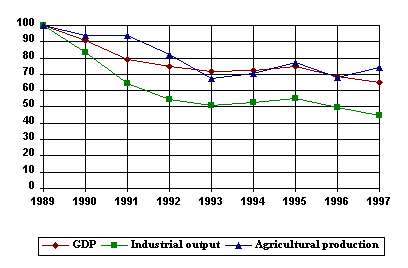
[page-number of print edition: 259]
The GDP has dropped by almost 40%. The decrease of industrial production is even more tangible. Impoverishment and unemployment are two of the dimensions of the economic situation which are directly related to the hidden economy. Both have reached impressive parameters during the last years. In the course of less than a decade the real incomes have decreased twofold. Large groups of the population are capable of meeting their basic needs only, and sometimes even this is a problem. A large segment of the society lives in absolute poverty. The self-assessments of the people about their financial situation adequately reflect the objective situation (Genov,1998):
Figure 2
Self-assessment of the financial situation of the households
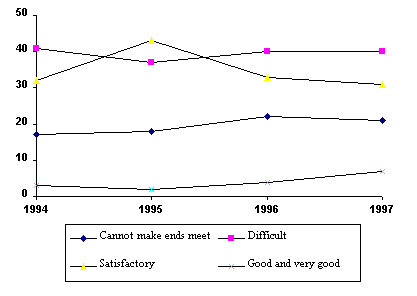
In the course of several years the virtually total employment was replaced by considerable unemployment (Chulev, 1998: 157):
[page-number of print edition: 260]
Figure 3
Unemployment in Bulgaria
The youth and long-term unemployment have emerged as particularly acute problems. A vicious circle was entered. Due to the impoverishment of the population the internal market considerably narrowed. At the same time, the Bulgarian goods were faced with the competition of legal and illegal imports. Cheap, low-quality goods and smuggled goods were welcomed by the impoverished population and hit the next blow upon the Bulgarian production. The traditional external markets were lost, and the access to new ones was obstructed by protectionist barriers and by the quality of most of the Bulgarian goods, which is inadequate to meet the requirements of the Western European consumers. The narrowed market imposes a decrease of production and dismissal of labour force. Then unemployment leads to further impoverishment and narrowing of demands. The self-assessments of the unemployed about their financial situation evidently support this finding.
[page-number of print edition: 261]
Figure 4
Self-assessment of the financial situation of the households of the unemployed
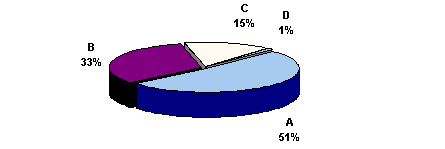
A - Cannot make ends meet B - Difficult
C – Satisfactory D - Good and very good
Impoverishment has already substantially limited the consumption. All reserves in this respect have been exhausted. It is exigent for the people to seek for increase in incomes. However, the access to legitimate sources of incomes is rather inadequate. Moreover, the finances obtained in this way are usually insufficient for the maintenance of a normal standard of life. Under these conditions the orientation towards hidden economic activities is quite natural. Money is vitally indispensable and highly important for the people who live on the verge of poverty. The reluctance to share the earnings with the state takes lead. Poverty, along with unemployment, becomes an important incentive for the participation of hired workers and self-employed in hidden economic activities.
The excessive supply of labour force provides the employers with the opportunity to hire workers at randomly determined conditions. However, they are also subjected to the pressure of
[page-number of print edition: 262]
the economic environment and are forced to lower the price of production in order to stand against the competition - especially against the one of the illegal imports. Precisely the hidden economic activity allows them to do that by saving from security and hygiene allowances, from social security payments, from remuneration, by using various flexible forms of employing and remunerating the workers.
3.2.Institutional conditions
There are several distinctive points in the institutional conditions which have been established lately. The first one is related to the labour and social legislation, and above all to its dynamics and adequacy. A part of these institutional norms, even those which have been created under the new conditions, are quickly wearing out and losing their adequacy. Some norms of the labour and social legislation impose a tremendous burden on the entrepreneurial activity. The attempts to evade them are objectively determined. The limited opportunities for flexible employing and remunerating of the labour force create serious difficulties for the employers.
The second point is related to the control and sanctions of the hidden economy. This field is not an exception from the general atmosphere of ineffective judicial activity on behalf of the state institutions, especially in the economic sphere. In spite of the evident growth of the economic crime during the last decade, its relative share in the registered crime has dropped from 8% at the end of the 1980s to 5.6% in 1997 (Crime in the Republic of Bulgaria in 1997). The relation between discovered and sanctioned crime also speaks for itself. The 32% increase in sanctioned economic crime in 1997 notwithstanding, the relation is still 16:1 (Crime in the Republic of Bulgaria in 1997). The state counteraction to the hidden economy is obviously weak and ineffective. There are numerous reserves in this sphere in terms of
[page-number of print edition: 263]
legislature, of the work of the state institutions and of their interactions - the interactions between the customs and tax services above all. The work of the employment services is also related to a certain extent to the hidden economy. The upgrading of the dynamics of their work and the improving of its effectiveness, along with the realisation of programs for alternative employment and other initiatives would narrow the flow of unemployed towards the hidden economy.
3.3. Sociocultural conditions
On the sociocultural scale the state of the value-systems, the legal consciousness and the attitude towards the state institutions are of greatest importance. In the course of the last decade the value-normative systems of the Bulgarian people have gone through considerable changes. The onset of the reforms opened the path for the replacement of the value patterns of statist egalitarianism by those of individualist liberalism. Key ideas, values and behavioural patterns which have formed and regulated individual behaviour throughout the previous decades were renounced. The criteria for good and bad became vague. The people massively lost landmarks and spiritual mainstay. The society fell in the condition of value disorientation and disintegration. Traditional national values were eroded. Labour tangibly lost its position in the value-hierarchy. It lost its prestige and value as a means for achieving individual prosperity (Zakharieva, 1997). A vacuum in the value-normative systems in the society opened up in the course of the replacement of traditional with modern values.
The crisis, the instability, and the high intensity of risks determined the extreme narrowing of the temporal perspectives in individual planning (Bulgaria 1997 ).
[page-number of print edition: 264]
Figure 5
Temporal horizons of life strategies
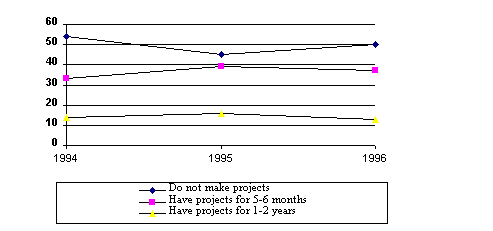
Empirical research shows that almost unchanging in the course of time, the views of the people are fixed in the reality „here and now". Most naturally, the domination of these attitudes would give priority to the solving of the current problems regardless of the concern with probable negative consequences in the future.
The economic insecurity strongly contributes to the narrowing of the temporal horizon of individual planning. This narrowing is especially grave in the case of the unemployed. The problems of the present day are especially dominant for them. The low culture of social insurance in the country and the lack of traditions for personal engagement and participation in social security insuring also adds its negative impact. Immediate incomes, regardless of the labour contract, the pension insurance and the security in case of temporary incapacity for work is generally preferred before the distant opportunities to find a job with a labour contract guaranteeing social benefits. The probability of the former choice is increasing in parallel with the growth of the pressure of the economic hardships.
[page-number of print edition: 265]
The state of the legal consciousness is an objective and undeniable reality (Mantarova, 1998).
Figure 6
Attitudes about law-abidance
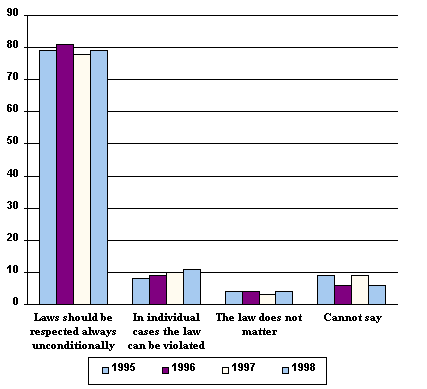
The annual gathering of data gives the opportunity to follow the dynamics of the process. Slowly, but persistently, the share of those people who consider that in individual cases the law can be violated is growing. The age distribution gives serious grounding to the prognoses that these processes would deepen in the forthcoming years. The findings that the young people are notably more liberal in their attitudes about law-abidance deserves particular attention.
[page-number of print edition: 266]
Figure 7
Relation between age and law-abidance attitudes
/November 1997, in %/
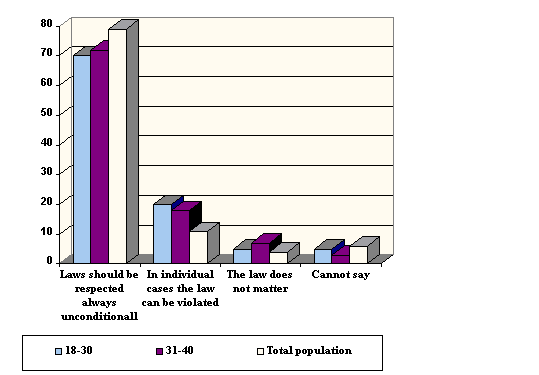
The attitudes towards the state and the state institutions also have a certain behaviour-constituting influence. The statist-oriented attitudes are strong and widely spread in contemporary Bulgarian society. Various studies show that there are high expectations directed to the state for solving the major problems of the society and the individual, job provision included. However, in reality the previous total employment was replaced by considerable unemployment after the start of the changes. The state proved to be unable to cope with it. The state institutions do not function effectively on the labour market, thus the trust in them
[page-number of print edition: 267]
suffers a crisis. The people no longer rely on them in their attempts to find work. They look for opportunities to solve the problem on their own, also by various ways of law violation. The incapability of the state to meet the expectations of the people incurs disappointment, distancing, and an orientation towards individual strategies for coping with the problems, including ones which are contrary to the interests of the others and to the legislative framework. The dissatisfaction with the state’s concern for the people’s well-being develops into a reluctance to respect its requirements.
Unemployment greatly contributes for the development of the hidden economy by providing a large supply of labour force willing to accept any working conditions. The impact of its economic consequences is also indisputable, for unemployment also considerably affects the way of thinking.
Empirical data show that the employment and social status are related to the legal consciousness (Mantarova, 1998).
Figure 8
Relation between social status and law-abidance attitudes:
Laws should be respected always unconditionally

[page-number of print edition: 268]
In the course of time the differentiation is increasing. It has increased by 6-8 points over two years only.
It should be especially taken into consideration that young people are subjected to an accumulation of preconditions which favour their inclusion in the hidden economy. Unemployment, long-term unemployment included, is higher among them. There are no real perspectives for successful labour realisation for a large part of the young people. Moreover, the legal consciousness of these age cohorts is more liberal to law violations. Researches also show that young people up to the age of 24 are most wanted on the black labour market. They are also the most inclined towards the development of a private business, hence there is an enhanced possibility for them to enter the hidden economy as hired workers, self-employed or employers.
3. The Perspectives
The dynamics of the hidden economy, its scale and forms would be most closely related to the alterations of the social processes which influence it. It can be assumed that the normative arrangements will be improved, that the adequacy of the legislation concerning the socio-economic conditions in the country would be increased. The institutions would stabilise, adapt to the new environment, and to the new methods and means of work. As a result of that, the control mechanisms would become stricter and more effective, and the state counteraction would strengthen. A certain positive change in the value-normative systems of the people can also be expected - namely a filling of the vacuum which had emerged during the replacement of the traditional institutions. The state and the society would stimulate the law-abiding conduct and would sanction the illegal one.
However, a weakening of the influence of poverty is less probable. The extremely low standard of living of a large part of the population has been maintained for too long, and the lagging behind of the legitimate incomes from the basic needs would
[page-number of print edition: 269]
hardly be overcome in the recent future. The unfavourable influence of unemployment would be even stronger. The long-delayed structural reform is inevitable, but the achievement of economic growth with a growing number of vacancies is not a very realistic perspective. The sustaining of high level of unemployment, especially long-term and youth unemployment, would have a strong immediate effect and would also exercise mediated influence on the way of thinking and the behaviour of the people. Hence, the measures for reducing unemployment would most directly stand for measures for limiting the hidden economy.
REFERENCES
CHAVDAROVA, T. (1996) 'The Informal Economies: Theoretical Approximation'. Sociological Problems, N 4.
CHULEV O. (1998) ‘The Labour Market in Bulgaria’. In: Genov N., Ed., Central and Eastern Europe: Continuing Transformation, Sofia-Paris: UNESCO-MOST and Friedrich-Ebert-Foundation, pp. 156-163.
CRIME IN THE REPUBLIC OF BULGARIA IN 1997 (1998) Sofia: (in Bulgarian).
GENOV, N., Ed. (1997a) Bulgaria - Today and Tomorrow. Sofia: Friedrich-Ebert-Foundation (in Bulgarian).
GENOV, N., Ed. (1997b) Bulgaria 1997. Human Development Report. Sofia: UNDP.
GENOV, N., (1998) ‘Central and Eastern Europe: Challenges of Continuing Transformation’. In: N. Genov, Ed. Central and Eastern Europe: Continuing Transformation, Sofia-Paris: UNESCO-MOST and Friedric-Ebert-Foundation, pp. 9-36.
[page-number of print edition: 270]
HRISTOSKOV, I., D. SHOPOV, I. BELEVA (1996) Uninstitutionalised Employment and Self-employment. Sofia, unpublished report (in Bulgarian).
HUNGARY. Human Development Report 1996 (1996) Budapest: UNDP.
MANTAROVA, A. (1998) ‘Unemployment and Crime’. In: Genov N., Ed. Central and Eastern Europe: Continuing Transformation, Sofia-Paris: UNESCO-MOST and Friedrich-Ebert-Foundation, pp. 284-298.
OVCHAROVA, L. (1996) ‘Shadow Economy’. In: Butenko, I.., K. Razlogov, Eds. Tendencies of the Sociocultural Development in Russia 1960-1990, Moscow (in Russian).
PANEV, B., V. PRODANOV (1996) ‘Boom of Crime in Bulgaria’. In:. Prodanov, V., M. Mizov, H. Moudrov, Eds. Boom of Crime in Bulgaria. Sofia: Choveshtina (in Bulgarian).
TODOROVA, S.(1998) ‘Prospects for Adaptation of the Bulgarian Labour market to the European Union’. In: Genov N., Ed. Central and Eastern Europe: Continuing Transformation. Sofia-Paris: UNESCO-MOST and Friedrich-Ebert-Foundation, pp. 309-317.
© Friedrich Ebert Stiftung | technical support | net edition fes-library | Februar 2000
